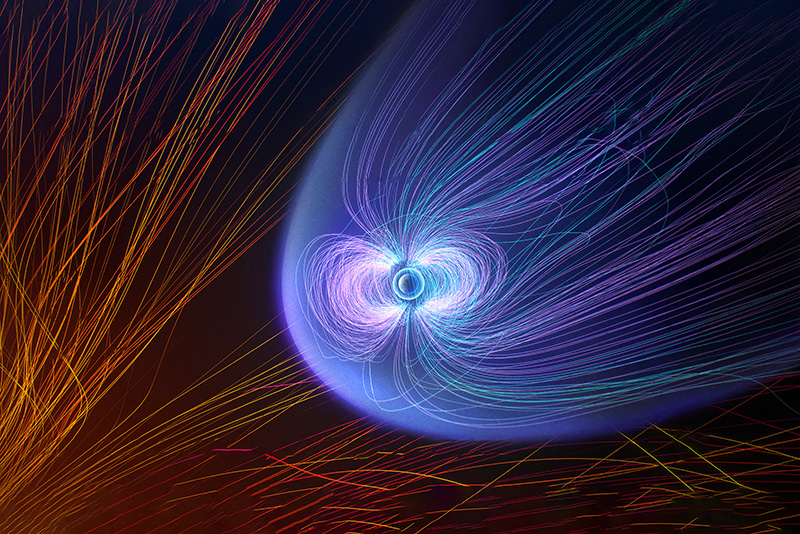Press Release
Johns Hopkins APL Publishes Report on Nation’s First Space Weather Simulation Exercise
Audio generated using AI voice technology.
The Johns Hopkins Applied Physics Laboratory (APL) in Laurel, Maryland, recently released the results of the nation’s first end-to-end Space Weather Tabletop Exercise (TTX), held in May 2024. The After-Action Report, published in March 2025, highlights the key findings and insights gained from the exercise.
Space weather events, such as solar flares and coronal mass ejections, can have significant effects on the nation’s infrastructure, economy and daily life. The TTX simulated these severe solar events and tested the government’s interagency coordination, response protocols and communications across a wide range of industry and critical infrastructure sectors, marking an important milestone in the nation’s preparedness for severe space weather.
Space weather experts — alongside those responsible for emergency management, response and recovery from 25 federal, state, tribal territory and local agencies — engaged in a hypothetical scenario that simulated a series of solar events with wide-ranging effects on Earth and the space between Earth and the Moon, including:
- Intense radiation exposure to satellites, astronauts and commercial aviation
- Radio communications outages and disruptions
- Loss of functionality or degraded performance of GPS for precision navigation and timing
- Reduced ability to communicate with and track on-orbit satellites
- Local- to regional-scale power outages, affecting railways and even pipelines
“This critical exercise provided awareness to senior government leaders while highlighting key research and observational gaps as well as best communication practices on the important topic of space weather,” said Ian Cohen, deputy chief scientist in APL’s Space Exploration Sector and the exercise’s science lead.
The TTX built on APL’s experience in hosting similar senior-leadership-level exercises across different topics and sectors — including planetary defense and global health — and the Laboratory was in the unique position to bring together a wide range of subject-matter experts, including heliophysics and space weather scientists, space systems engineers, national security and critical infrastructure experts, and emergency preparedness and response leaders.
The After-Action Report identified several key findings and recommendations, including:
- Demonstrating the need for better coordination to produce meaningful and understandable space weather notifications that clearly describe the potential impacts on critical infrastructure
- Emphasizing the importance of a whole-of-government approach, especially federal-regional-state-level coordination and awareness, while also highlighting existing gaps that need to be filled to ensure a streamlined and rapid response
- Highlighting opportunities to understand current technology limitations and discussing possibilities for improved forecasting capabilities, including suggestions to place spacecraft farther upstream (closer to the Sun) for earlier warning of impending storms
- Underscoring the need for a national space weather education campaign to raise awareness of risks and improve public understanding
- Demonstrating the need for a more coordinated and streamlined communications plan with the public through federal, state and local agencies, and on social media
- Showcasing the benefits of a whole-of-government exercise to prepare for scientifically complex threats
Dipak Srinivasan, a program area manager in APL’s Space Exploration Sector and the APL exercise manager, noted that “the TTX was a critical step in the nation’s preparedness for severe space weather events. We at APL are proud to have brought the breadth and depth of our capabilities to lead this and other types of interagency activities on behalf of our sponsors. It allows us to provide realistic exercise scenarios that would stress our systems, helping inform agencies across government about the technical, communications and policy gaps in our space weather readiness.”
In a remarkable coincidence, a significant real-world space weather event — the largest geomagnetic disturbance in more than 20 years, the “Gannon Storm” — occurred at the same time as the exercise. Several key participants had to simultaneously manage both the real-world needs of the nation and the simulated actions of the TTX, highlighting the importance of preparedness and the relevance of the exercise to real-world events. The TTX was developed independently and did not replicate the event or intentionally align with the timing.
The TTX was sponsored jointly by the National Oceanic and Atmospheric Administration (NOAA), the National Aeronautics and Space Administration (NASA), the National Science Foundation (NSF) and the Federal Emergency Management Agency (FEMA). Leveraging its expertise in space weather research, APL developed the content for the exercise in coordination with NOAA, NASA, NSF and FEMA. APL coordinated, hosted and executed the exercise and also collected, collated and reported the data and results.

